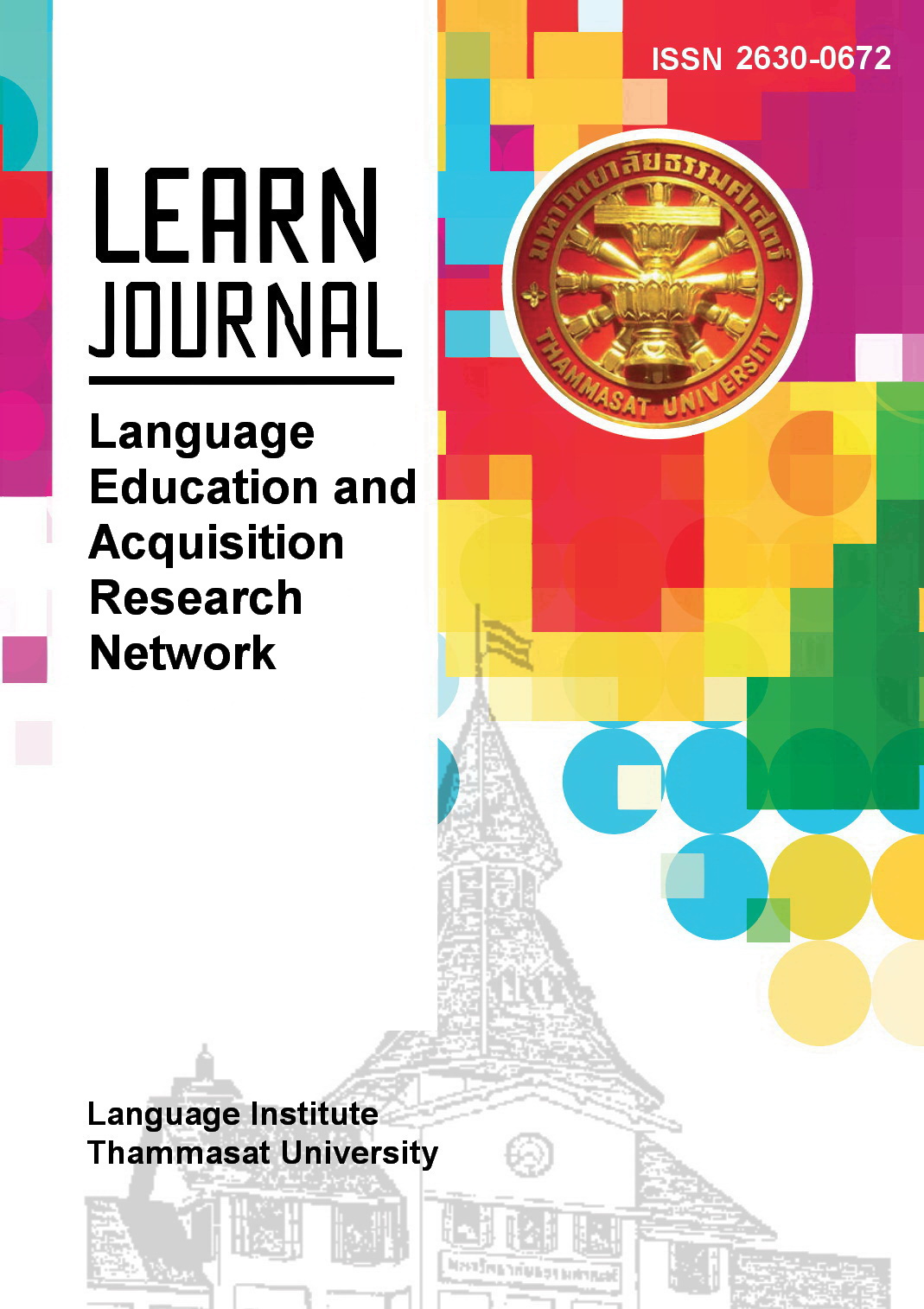A Corpus-based study of the synonyms cease, halt, and stop
Main Article Content
Abstract
This study aims to investigate the distribution across genres and the collocation of three synonymous verbs cease, halt, and stop. Data were from drawn from the Corpus of Contemporary American English (COCA). The results from the distribution across genres shed light on the degree of formality of each verb. The verb stop appears to have a low degree of formality since it occurs most frequently in the TV and movie subtitles genre, an informal genre and occurs least frequently in formal contexts, i.e., the genre of academic texts. The verbs cease and halt, in contrast, appear to have a higher degree formality as they occur least frequently in informal contexts, i.e., the spoken genre. Furthermore, it was found that the three verbs share certain collocates and themes, confirming their status as synonyms. However, despite these similarities, there are collocates and themes that are not shared. Hence, the synonymous verbs can be differentiated from each other based on the degree of formality and the collocation. Due to the difference in usage, they cannot be substitutable in all contexts.
Article Details
References
Begagić, M. (2013) Semantic preference and semantic prosody of the collocation make sense. Jezikoslovlje 14(2-3), 403-416.
Edmunds, P. &Hirst, G. (2002). Near-Synonymy and lexical Choice. Computational Linguistics, 28(2), 105 -144.
Evert, S. (2007). Corpora and collocations. In A. Lüdeling & M. Kytö (Eds.), Corpus linguistics. An international handbook, article 58. Mouton de Gruyter.
Gu, B. (2017). Corpus-Based study of two synonyms—Obtain and Gain. Sino-US English Teaching, 14(8,), 511-522.
Inkpen, D. & Hirst, G. (2006). Building and using a lexical knowledge base of near-synonym differences. Computational Linguistics, 32(2). 223-262.
Jarunwaraphan, B. & Mallikamas, P. (2020). A corpus-based study of English synonyms: Chance and pportunity. rEFLections, 27(2), 218-245.
Kruawong, T. & Phoocharoensil, S. (2022). A genre and collocational analysis of the near-synonyms Teach, Educate, and Instruct: A corpus- based approach. TEFLIN Journal, 33(1), 75 - 97.
Li, E. (2019). A corpus-assisted study of synonyms in EFL teaching: Take preserve and conserve as examples. Linguistics and Literature Studies 7(2): 39- 50.
Martin, M. (1984). Advanced vocabulary teaching: The problem of synonyms. The Modern Language Journal, 68(2), 130 -137.
Merriam-Webster. (n.d.). Cease. In Merriam-Webster.com dictionary. Retrieved June 14, 2022, from https://www.merriamwebster.com/dictionary/cease
Merriam-Webster. (n.d.). Halt. In Merriam-Webster.com dictionary. Retrieved June 14, 2022, from https://www.merriam- webster.com/dictionary/halt
Merriam-Webster. (n.d.). Stop. In Merriam-Webster.com dictionary. Retrieved June 14, 2022, from https://www.merriam-webster.com/dictionary/stop
Neighbor or Collocate Statistics. (n.d.). https://wordcruncher.com/pdf/neighborhood-stat-formulas.pdf
Oxford University Press. (2014). Cunning. In Oxford Advanced Learner’s Dictionary. Oxford University Press.
Oxford University Press. (n.d.). Cease. Inoxfordlearnersdictionaries.com/definition/american_english dictionary. Retrieved June 14, 2022, from https://www.oxfordlearnersdictionaries.com/definition/american_english/cease?q=cease
Oxford University Press. (n.d.). Halt. Inoxfordlearnersdictionaries.com/definition/american_english dictionary. Retrieved June 14, 2022, from https://www.oxfordlearnersdictionaries.com/definition/american_english/halt_1?q=halt
Oxford University Press. (n.d.). Stop. Inoxfordlearnersdictionaries.com/definition/american_english dictionary. Retrieved June 14, 2022, from https://www.oxfordlearnersdictionaries.com/definition/american_english/stop_1?q=stop
Pearson Education. (2014). Clever. In Longman dictionary of contemporary English. Pearson Education.
Pearson Education. (n.d.). Cease. In Idoceonline.com dictionary. Retrieved June 14, 2022, fromhttps://www.ldoceonline.com/dictionary/cease
Pearson Education. (n.d.). Halt. In Idoceonline.com dictionary. Retrieved June 14, 2022, from https://www.ldoceonline.com/dictionary/halt
Pearson Education. (n.d.). Stop. In Idoceonline.com dictionary. Retrieved June 14, 2022, from https://www.ldoceonline.com/dictionary/stop
Petcharat, N. & Phoocharoensil, S. (2017). A corpus-based study of English synonyms: Appropriate, Proper, and Suitable. LEARN Journal: Language Education and Acquisition Research Network, 10(2), 10 -24.
Phoocharoensil, S. (2020a). Collocational patterns of the near-synonyms Error, Fault, and Mistake. The International Journal of Communication and Linguistic Studies, 19(1), 1-17.
Phoocharoensil, S. (2020b). A genre and collocational analysis of consequence, result, and outcome. The Southeast Asian Journal of English Language Studies, 26(3), 1 – 16. http://dx.doi.org/10.17576/3L-2020-2603-01
Phoocharoensil, S. (2021). Semantic prosody and collocation: A corpus study of the near-synonyms persist and persevere. Eurasian Journal of
Applied Linguistics, 7(1), 240 -258.
Phoocharoensil, S. & Kanokpermpoon, M. (2021). Distinguishing the near-
synonyms ‘increase’ and ‘rise’: Genre and collocation investigation.
Kasetsart Journal of Social Sciences, 42, 968–975.
Reppen, R. and Simpson-Vlach, R (2010). Corpus Linguistics. In N. Schmitt (Ed), An introduction to Applied Linguistics (pp. 89 -105). Hodder Education.
Shin, D. & Nation, P. (2007), Beyond single words: The most frequent collocations in spoken English. ELT Journal, 62(4), 339-348.
Sinclair, J. (1991). Corpus, concordance, collocation: Describing English language. Oxford University Press.
Smyth, C. (2016). An introduction to Corpus Linguistics. Bulletin of Tokyo Denki University, Arts and Sciences, 14, 105 -110.
Stubbs, M. (1995). Collocations and semantic profiles: On the cause of the trouble with quantitative studies. Functions and language 2(1), 23–55.
Thornbury, S. (2002). How to teach vocabulary. Longman.
Webb, S., & Nation, P. (2017). How vocabulary is learned. Oxford University Press.


